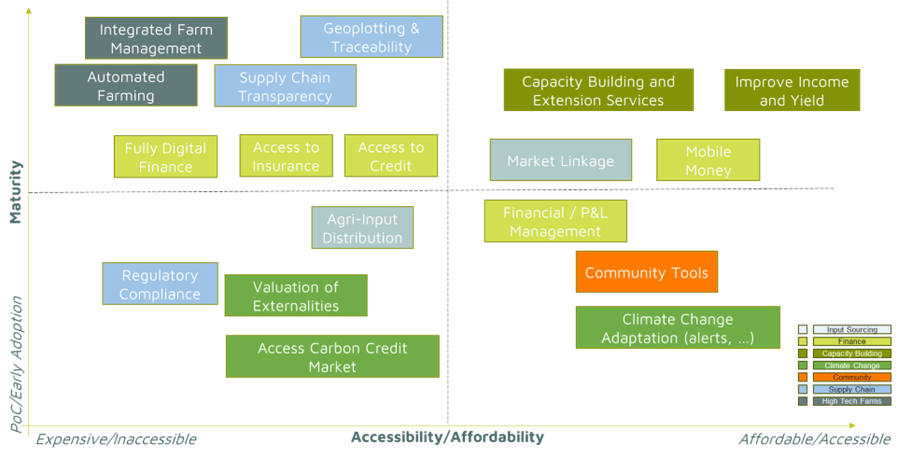On November 7th, 2023, at 6:45 pm CET we hosted an event for ICTforAG 23, on how best to leverage low-tech digital solutions for agricultural transformation across the global south.
Exciting speakers from across the globe joined us to share their expertise and experiences:
- Emily Sylvia, Manager, J-PAL, US
- Swarup Ghosh, CEO, Tomorrow’s Foundation, India
- Tharusha Wanigasekera, Unit Manager – Digital Innovation and Inclusion, Dialog Axiata, Sri Lanka
- Christian Chateauvieux, Director of Digital Solutions, Ksapa
- Facilitator: Raphaël Hara, Managing Director, Ksapa
This blog post summarizes some key learnings and action points from the session. See the session here.
Digital Innovations shape the future of agriculture but most of the world’s farms are left behind
There’s a lot of buzz about the future of agriculture all the way from AI, Blockchain, and IoT to driving climate change adaptations, creating carbon credits through sustainable agriculture, supply chain transparency and all-new GMO seeds. But these innovations don’t reach smallholder farmers across the global south and they remain largely under served – as well as a data black hole.
Why does this matter?
Because smallholder farmers more than 500 million across the globe, comprising of 84% of global farms, use 24% of all agricultural land. Further, they produce 1/3 of global food crops and more than 80% of food in Asia and Africa hence playing a vital role in food security. Despite this, ¾ of them face hunger.
Their challenges and needs are quite fundamental, such as
- Access to proper seedlings, intrants, safe water
- Access to market
- Lack of education
- Limited access to technology
- Financial inclusion
- Climate change adaptation & biodiversity depletion
- Access to decent living income
Digital solutions if built correctly with the right target audience in mind can go to great lengths in addressing these issues. So why haven’t they?
Simply put, digital solutions often don’t have these smallholders – and more generally vulnerable populations – in mind while being built. More specifically, there are two shortcomings in their applicability:
- Lack of appropriate equipment (smartphones & computers, mainly) and network infrastructure
- Lack of solutions that combine the high quality of data offered by high-tech and the wide reach of low tech
Lack of smartphone ownership, usage and network infrastructure
In Sub-Sharan Africa there is a network coverage gap of 19%, meaning that more than 200 Million rural people in the region don’t have access to a stable mobile network. More alarmingly, there is a usage gap of 53%, (those who live within the footprint of a mobile broadband network but are not using mobile internet services) and only 28% of the population uses the internet.
In Latin America, MENA, South Asia and East Asia, while the coverage gap is less than 7%, the usage gap ranges between 40-60%. Indicating a majority rural population in these regions don’t use internet due to them not having smartphones or not knowing how to use it.
The Missing Middle: Lack of solutions that combine the high quality of data offered by high-tech and the wide reach of low-tech
Given the network infrastructure and smartphone usage/ownership gap, developing solutions that work on all types of devices and network contexts is necessary. But these solutions often lack the quality of information needed to inform transformational changes to agriculture. On the other hand, the high-tech is not affordable nor accessible for the smallholders, who often struggle to make ends meet.

What we need is a strategic look at what types of solutions are ripe for the current needs and affordability
Digital solutions can be broadly classified into 7 categories based on their end output:
- Input Solutions
- Finance
- Capacity Building (Extension Services)
- Climate Change
- Community
- Supply Chain
- Precision Farming (High Tech Farming)
Within these broader categories, there are specific solutions, each with different levels of maturity and Accessibility. This has been mapped below.

Through our analysis, we have found that, for most product categories, there are very few solutions which cater to the needs of the smallholder farmers in the global south.
On the top right-hand side corner are solutions which are being deployed at a great scale due to them being both accessible and mature. Beyond this, the bottom right quadrant is a high potential area for deployment to smallholders given their affordability. A lot of private and public capital is also flowing into this space.
After making a conscious decision on which type of solutions to implement, we need to consider How to implement them
Some key success factors for Low Tech ICTs are:
- Blending Offline and Digital: Leveraging governments’, NGOs’ and/or industrial companies’ extension staff but also partnerships to equip farmers with digital tools
- Building context-specific tools: Tech adapted to the local needs, crops grown, soil type, pest & disease and current capacities.
- Continuous Low Tech support: App Free, low-tech continuous extension service to provide tailored support and communication. For Example: In several countries, hotlines to call people that can answer you over the phone/WhatsApp.
- Demonstrate value proposition: Offer strong value/incentive to farmers for engaging with the program.
- Win the Trust of Farmers: Building trust about data collection and usage for smallholders. Governments want to build large databases on farmers which would allow them to build tailored programs with improved data collection, this needs to be done while ensuring smallholders feel safe about sharing their data.
Building on this discussion our speakers added their unique expertise to our discussion.
What evidence do we have to show that ICTs can work?
Emily Sylvia from J-PAL, US added a perspective on what current peer-reviewed research shows to be effective for ICTs.
In terms of delivery, she recommended frequent and well-timed touch points with the farmers. For instance, if harvest and storage information are delivered approaching the harvest season, farmers feel more compelled to act on them. Secondly, SMS and Videos are consistently proven to be effective as mediums of information delivery.
But a key caveat is that learning, and retention appear to not be equated to more profits for the farmers. So due care needs to be taken in providing action points farmers can control and act on. To solve for this, she recommends:
- Ensure the delivery mechanism meets the farmer’s context, needs and timing.
- Tailoring and Targeting of the content and medium of delivery
On the field, whats holding back tech adoption by smallholders?
Swarup Ghosh, CEO and co-founder of Tomorrow’s Foundation, India operates a non-profit in the eastern part of the country. He shared some ground realities of what farmers needs are and why ICTs have not yet taken over in the region.
Firstly, he highlights that tech or tech-driven information is hard to implement and rarely useful. He points out that weather forecasts and good agricultural practices are often not actionable, or not relevant. Further, they don’t have know-how of how to market their produce and don’t have access to essential insurance relating to their agriculture.
The greatest hurdle for tech adoption by these farmers is a severe lack of digital literacy and a lack of appropriate mobiles or reliable networks.
However, what has been selectively effective is the use of popular social media like WhatsApp or Facebook in disseminating good agricultural practices, Agri input information and weather alerts. This is primarily driven by the farmer’s familiarity with these platforms.
What are some Low-tech solutions that are working? Why?
Tharusha Wanigasekera, Unit Manager at Dialog Axiata, lead mobile operator in Sri Lanka, shared with us some tech Dialog built for farmers.
- Govi Mituru: This is a daily voice-calling advisory and alert service that anyone can access as of Rs 1 per day per crop (equivalent to +-1 € per year). It also provides SMS follows and is hyper-localised to Sri Lanka
- Saru: An ecosystem of Internet of Things (IoT) applications was developed for affordable climate-smart, automated, protected agriculture for smallholder farmers which automates many farming processes based on the time and needs of the crop
Finally, Ksapa’s Director of Digital Solutions, Christian Chateauvieux, presented SUTTI, a low-tech offline capable application which works across contexts and is designed with farmer centricity in mind. While its core offering is helping smallholders access Good Agricultural Practices and measuring their impact, we are slowly expanding it for other use cases. Know more about it here.
A quick snapshot of the discussion:

Iman works across the consulting team and SUTTI program at Ksapa.
He is a second-year student at HEC Paris in the Grande École program specialising in Impact Investing. He has over 3 years of experience in growth and innovation consulting for large corporates across SEA, South Asia and Latin America. More recently he was an investment analyst at an early-stage VC in India.
Iman speaks English, Hindi, Bangla and Punjabi.



